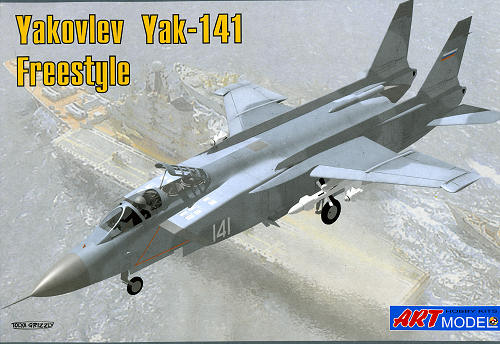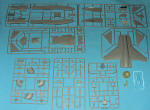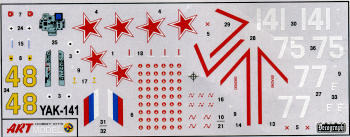
Art Model 1/72 Yak-141 'Freestyle'
| KIT #: | AM 7205 |
| PRICE: | $28.95 from www.scale-model-kits.com |
| DECALS: | Four options |
| REVIEWER: | Scott Van Aken |
| NOTES: |

| HISTORY |
Yakovlev always believed the Yak-38 to be an interim aircraft, developed to gain experience designing and developing military VTOL aircraft. Even before the Yak-38's introduction, the Soviet Navy desired a more comprehensive aircraft, with greater capabilities than the Yak-38 offered. The result was a design contract offered to Yakovlev in 1975 without any competition. The requirement was for an aircraft with only one mission: air defense of the fleet. Unlike the Yak-38, this aircraft was to have sustained supersonic speed. Maneuverability, radar and weapons loads were expected to be similar to those of current front-line fighters. For the Soviet Navy this aircraft was to be their next generation VTOL fighter. For Yakovlev the aircraft was viewed as a way of returning to designing Soviet fighter aircraft.
Because of the importance and complexity of the project, Alexander Sergeyevich Yakovlev assigned a large portion of his OKB to the development of the new VTOL fighter, with no fewer than ten chief engineers working simultaneously on what was called "Product 48" (the military had designated it Yak-41). Over fifty designs were studied. One key problem was designing an aircraft with both vectoring thrust and an afterburner, which was essential for sustained supersonic speeds. A twin-engine design was considered, but abandoned as the loss of an engine on landing would result in an immediate roll to the side. Eventually it was decided that the best arrangement was a single vectoring nozzle located just behind the center of gravity, as well as dedicated vertical thrust jets positioned just behind the cockpit. A considerable amount of time was spent in the development of a flat, rectangular nozzle similar to that later employed on the American F-22 Raptor. Such a nozzle proved well-suited for the changes in configuration needed for both thrust vectoring and supersonic flight, and allowed for a thin, shallow tail. Ultimately, a circular nozzle was used, located between twin booms supporting the twin-finned tail.
The final design bore a strong resemblance to other contemporary fighters such as the MiG-25 and American F-15 Eagle. Parts that were to be subjected to excessive heat from the engines during landing were manufactured of titanium, and no less than 26% of the overall aircraft was to be manufactured of graphite or composite material. Because of heat build-up, hovering was restricted to no more than 2 1/2 minutes.
All three engines were controlled through an interlinked digital system, which was capable of controlling both engine start-up as well as modulating the thrust of all three engines during landing and hovering flight. Twin tandem reaction control jets were positioned at the wingtips, while a swiveling yaw jet was positioned under the nose.
The cockpit was pressurized and air-conditioned. The small canopy was bulletproof in front. It hinged to the right, but because of a long dorsal spine it had no rear vision. The ejection seat was automatically armed as soon as the engine duct was rotated past 30 degrees with an airspeed of less than 300 km/h (186 mph). The instrumentation in the prototypes was simple and similar to that planned for the earlier Yak-36M. The production version was to have been fitted with an extensive avionics and weapons suite including doppler radar, laser-TV ranging and aiming, as well as a heads-up multifunction display (HUD) which worked in connection with a helmet-mounted missile aiming system as found on the Mikoyan MiG-29. This system allows the pilot to lock onto an enemy aircraft by turning his head as far as 80 degrees from front.
The undercarriage was tricycle, and equipped with the latest multi-disc, anti-skid brakes. The steerable nose wheel retracted to the rear, while the main gear retracted forward.
The top mounted wing was similar to that used on the Yakovlev Yak-36, though the outer panel swept back, and could be folded up for shipboard storage. The main engine was served by four side-mounted ducts as well as a row of large louvers along the upper surface to allow air to enter the engine during full power hovering. This engine was the R-79V-300, a two-shaft augmented turbofan with a bypass ratio of 1. Maximum thrust was 14,000 kg (30,864 lb). The rear nozzle could rotate from 0 degrees to 95 degrees for VTOL landing and hovering. The two lift engines were the RD-41 design, a simple single-shaft engine made mostly of titanium. Each had a thrust of 4,100 kg (9,040 lb). The engines were installed behind the cockpit at an angle of 85 degrees. Like the Yak-38, the engines received their air through eight spring-operated dorsal flaps, and the exhaust exited through a belly opening covered by two ventral doors.
Despite efforts to keep the program alive once the fall of the Soviet Union essentially removed all funding, little was accomplished. However, Lockheed/Martin did provide funding for additional work and to allow the prototypes to keep flying for a few more years. Some sources state there was also some collaboration between L-M and Yakovlev to incorporate some of the Yak-141's technology into the F-35 Joint Strike Fighter, and there is a superficial similarity between the two aircraft. Despite efforts to renew the 141 program, it appears it is pretty well a dead issue.
| THE KIT |
 Art Model has a number of interesting kits in its repertoire and this one adds to it. Molded in a light grey plastic, the kit comes in a zip lock bag inside a sturdy cardboard box. I like it when a company provides a resealable bag for its kits as it makes keeping loose parts from disappearing. The kit also includes a pair of resin parts for the engine exhaust and the bang seat, a good choice as the ejection seat should be as detailed as one can make it. There is also a clear, one-piece canopy.
Art Model has a number of interesting kits in its repertoire and this one adds to it. Molded in a light grey plastic, the kit comes in a zip lock bag inside a sturdy cardboard box. I like it when a company provides a resealable bag for its kits as it makes keeping loose parts from disappearing. The kit also includes a pair of resin parts for the engine exhaust and the bang seat, a good choice as the ejection seat should be as detailed as one can make it. There is also a clear, one-piece canopy.
The molding is very nicely and crisply done engraved panel lines. I would have liked fewer pieces for the fuselage, but I understand that this is how it has to be done with a design like this. The nose section is a separate piece, and I suspect that perhaps a two seat version may be in the offing. The cockpit is pretty basic with the aforementioned resin seat, control stick and instrument panel. Instruments for the forward panel and side consoles are decals, something that is rather standard for 1/72 kits.
The kit offers the option of having the forward engine lift doors open and the aft nozzle pointed down or with the nozzle pointed straight aft. There is a separate construct for either of these options and one will have to do some trimming on the lower engine cover for the nozzle down option. There is good compressor and exhaust detail for the forward lift engines as these will be easily seen with the upper and lower doors open. Four weapons pylons are provided as well as two different missiles for these pylons.
 Instructions are well done and are in photo or photo-realistic detail. Each of the parts is numbered in the illustrations and though it isn't the normal presentation for most of us, should provide no barriers to construction. There is no indication of color during construction so you are on your own when it comes to cockpit, wheel well, landing gear and wheel shades. Frankly, I'm not sure why so many newer companies seem to ignore what I think is rather an important part of the build. The decal sheet is well printed by Decograph with the markings quite matte. The markings instructions show two planes; white 141 and white 77, though there are other markings on the sheet. White 77 is an overall grey (and though there is a reference, it means nothing to me as I've no idea what 'akah 73059' stands for). White 141 is in a two tone grey as shown on the box art.
Instructions are well done and are in photo or photo-realistic detail. Each of the parts is numbered in the illustrations and though it isn't the normal presentation for most of us, should provide no barriers to construction. There is no indication of color during construction so you are on your own when it comes to cockpit, wheel well, landing gear and wheel shades. Frankly, I'm not sure why so many newer companies seem to ignore what I think is rather an important part of the build. The decal sheet is well printed by Decograph with the markings quite matte. The markings instructions show two planes; white 141 and white 77, though there are other markings on the sheet. White 77 is an overall grey (and though there is a reference, it means nothing to me as I've no idea what 'akah 73059' stands for). White 141 is in a two tone grey as shown on the box art.
| CONCLUSIONS |
Overall, this looks like a very nice kit. I think the only other kits of this plane have been in resin such as the one Anigrand has produced. Not only is this a nicely molded injected styrene kit, it is at a price that won't send you to the bank for a loan!
| REFERENCES |
http://en.wikipedia.org/wiki/Yakovlev_Yak-141
Thanks to www.scale-model-kits.com for the preview kit. Get yours at the link and at a discount.
If you would like your product reviewed fairly and fairly quickly, please contact the editor or see other details in the Note to Contributors.